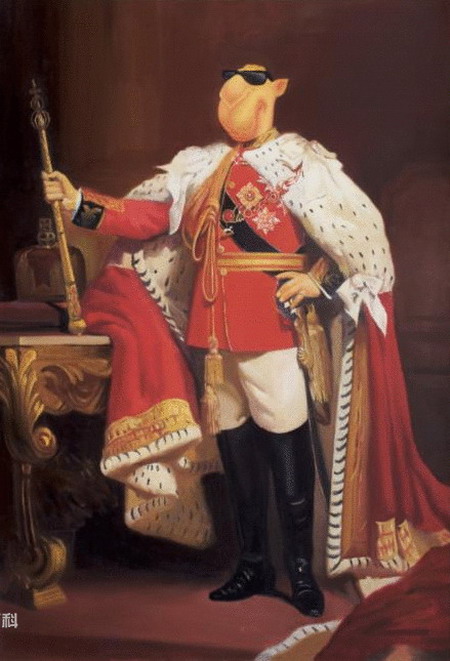
|
|
A painting by Zhou Tiehai. [Photo/Baidu.com]
|
Zhou Tiehai is an extraordinary facilitator and clever conceptual artist. Both of these traits have made him a successful contradiction in the contemporary Chinese art world of the past 12 years. He has encouraged a younger generation of artists to think about new and unique approaches to identifying themselves.
A graduate of the Shanghai College of Fine Arts in painting and design, Tiehai began his career in advertising, something he was never really drawn to but thought would be a good move in the early 1990s when he couldn’t seem to find a direction for his art. Even though he has been associated at times with the 1980s New Wave Art Movement, he says, “I had no interest in Political Pop art, or Cynical Realism, or anything else other Chinese artists were doing at that time. When everyone else was making statements, I had no statement to make.” However, he still preferred fine arts to commercial art.
When the writer Andrew Solomon came to China in 1993 to do a feature on contemporary Chinese art for the New York Times magazine, he met Tiehai but ultimately did not mention him in the article. This had a profound effect on Tiehai and he decided that it was time to “get back into art.”
He says that he made a study and concluded that what appeared to be the most important thing in the art world in general was to get people to believe you were famous, no matter what you might do to support that. Going against the media he didn’t respect and a conditional art market he didn’t like, he parodied both, creating a series of paintings of magazine covers featuring himself. In these, Art in America, Flash Art, and Newsweek all praised Tiehai. This conceptual calculation brought him attention and he decided to keep it going.
For his first extended series entitled Placebo, begun in 1997, he appropriated the image of Joe Camel from American cigarette advertising, placing the head of the camel on the bodies of familiar aristocrats in Renaissance paintings or on David’s Odalisque. He produced them in acrylic with an airbrush, a technique borrowed from his commercial art days. Additionally, Tiehai’s paintings were not produced by his own hand. He hired assistants to carry out the process of making the art he conceived.
Sitting in his relatively small studio in a co-op building in the center of the M-50 art district in Shanghai, Tiehai told me recently, “I didn’t see the need then, nor do I now, to make the paintings myself. It is the concept that is the creative part, and besides, most of the artists I know are not especially good painters, they are just famous.”
Critics agree that the device of Joe Camel functions on multiple levels but at its best, is an alter-ego for Tiehai that allows him to criticize what he believes is overplayed and over-promoted. In a later series entitled Ego, he appropriated the imagery of every contemporary artist from Jeff Koons to Cindy Sherman, all using his Joe Camel head. While this has become what he is best known for by collectors worldwide, putting him in a category he started out ridiculing, like the majority of contemporary Chinese artists I have met, he has begun to reference classical Chinese art as a means of connecting to his cultural history. His Tonic series is comprised of copies of masterworks by brush painters. Creating them with airbrush in acrylic, they retain the softness of brush and ink but the images are cropped and enlarged to the degree that they become abstract.
The irony of Tiehai’s current status is that his presumed attack on the branded type of Chinese art made by his contemporaries 12 years ago has made him equally recognized and respected, so much so that he was recently hired as vice-director of the Minsheng Art Museum, representing the China Minsheng Bank. Tiehai’s first curated exhibit at the museum was, interestingly, Thirty Years of Contemporary Chinese Art History!
By JON BURRIS
JON BURRIS is a recognized photographer and writer, and has authored seven books on contemporary art and photography. His photographs are a part of private and institutional collections internationally.
